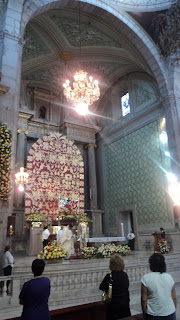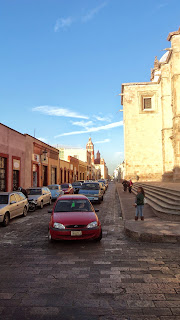The first missionaries in many parts of the Nueva Espana were the Franciscans. This is the Church of San Francisco. Construction started in 1550, but it was not finished until the early part of the XVII Century.
The style of the Church of San Francisco is an austere baroque. On the façade, beside the bell tower, we find the clock and the relief that shows Santiago Matamoros. In his name, the Franciscans name this city, Santiago de Queretaro. Santiago is Spanish is actually two words in one, Sant and iago. Sant means Saint and Iago was the Hebrew word for James. According to the customs and beliefs, the Apostle James died in the northwestern part of Spain, in a place now called Santiago de Compostela.
The Spaniards believed it was Santiago who helped them win their centuries old conflict with the Mores. That is why Santiago is named Santiago Matamoros, or James, the Slayer of Mores.
Franciscan churches are elegant in their simplicity. This is the case of San Francisco, Queretaro. It has a warm feeling, and even the poorest Indians that come walking for hours from far away villages feel at home. Sometime, I believe Europeans never understood Saint Francis, but humble Mexicans seem to understand him perfectly. Saint Francis was a radical It is said that the Pope, Innocent III, didn't know what to do with Francis, to excommunicate him or canonize him.
Giotto drew a painting of Innocent III sleeping or having a nightmare about Saint Francis. Giotto always a great sense of humor, and the painting shows the Pope sleeping, while the Church outside his bedchamber is so slanted that it looks like a ship sinking into the sea, except, that in the corner, Saint Francis appears, and supports the faltering structure;
Saint Francis was a very large figure in the Church during the XIII century. His followers, the first missionaries of the Nueva Espana, like Motolinia, were larger than life. Even Landa, with his unforgiveable act of burning the Mayan Codex, was a man who tried to do everything possible in the Yucatan to bring two cultures together into one. We saw this in Izamal, near Merida, Yucatan, where he built a Basilica, on top of the Pyramid of Izamal. The Mayas come from all over the Yucatan peninsula in pilgrimage to visit the Virgin of Izamal.




















































